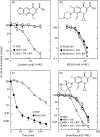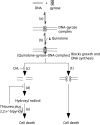Contribution of reactive oxygen species to pathways of quinolone-mediated bacterial cell death
- PMID: 20067982
- PMCID: PMC2818107
- DOI: 10.1093/jac/dkp486
Contribution of reactive oxygen species to pathways of quinolone-mediated bacterial cell death
Abstract
Background: Quinolone-mediated death of Escherichia coli has been proposed to occur by two pathways. One is blocked by inhibitors of protein synthesis; the other is not. It is currently unknown how these two pathways fit with the recent observation that hydroxyl radical accumulation is associated with quinolone lethality.
Methods: E. coli was treated with thiourea plus 2,2'-bipyridyl to block hydroxyl radical accumulation, and the effect on quinolone lethality was measured for quinolones that distinguished the two lethal pathways: oxolinic acid requires protein synthesis to kill E. coli, while PD161144, a C-8-methoxy fluoroquinolone, does not. The lethal activity of another fluoroquinolone, moxifloxacin, was partially blocked by the presence of chloramphenicol, an inhibitor of protein synthesis. That feature made it possible to determine whether the effects of chloramphenicol and thiourea plus 2,2'-bipyridyl were additive.
Results: Lethal activity of oxolinic acid was completely blocked by thiourea plus 2,2'-bipyridyl and by chloramphenicol. In contrast, PD161144 lethality was unaffected by these treatments. With moxifloxacin, both chloramphenicol and thiourea plus 2,2'-bipyridyl separately exhibited the same partial inhibition of quinolone lethality. No additivity in protection from moxifloxacin lethality was observed when thiourea, 2,2'-bipyridyl and chloramphenicol were combined and compared with the effect of chloramphenicol or thiourea plus 2,2'-bipyridyl used separately.
Conclusions: Inhibitor studies indicated that hydroxyl radical action contributes to quinolone-mediated cell death occurring via the chloramphenicol-sensitive lethal pathway but not via the chloramphenicol-insensitive pathway.
Figures


Similar articles
-
Inhibitors of reactive oxygen species accumulation delay and/or reduce the lethality of several antistaphylococcal agents.Antimicrob Agents Chemother. 2012 Nov;56(11):6048-50. doi: 10.1128/AAC.00754-12. Epub 2012 Sep 4. Antimicrob Agents Chemother. 2012. PMID: 22948880 Free PMC article.
-
Effect of anaerobic growth on quinolone lethality with Escherichia coli.Antimicrob Agents Chemother. 2007 Jan;51(1):28-34. doi: 10.1128/AAC.00739-06. Epub 2006 Oct 16. Antimicrob Agents Chemother. 2007. PMID: 17043118 Free PMC article.
-
Reactive oxygen species play a dominant role in all pathways of rapid quinolone-mediated killing.J Antimicrob Chemother. 2020 Mar 1;75(3):576-585. doi: 10.1093/jac/dkz485. J Antimicrob Chemother. 2020. PMID: 31793990
-
Contribution of oxidative damage to antimicrobial lethality.Antimicrob Agents Chemother. 2009 Apr;53(4):1395-402. doi: 10.1128/AAC.01087-08. Epub 2009 Feb 17. Antimicrob Agents Chemother. 2009. PMID: 19223646 Free PMC article.
-
Bacterial death from treatment with fluoroquinolones and other lethal stressors.Expert Rev Anti Infect Ther. 2021 May;19(5):601-618. doi: 10.1080/14787210.2021.1840353. Epub 2020 Nov 16. Expert Rev Anti Infect Ther. 2021. PMID: 33081547 Review.
Cited by
-
Iron Chelator DIBI Suppresses Formation of Ciprofloxacin-Induced Antibiotic Resistance in Staphylococcus aureus.Antibiotics (Basel). 2022 Nov 17;11(11):1642. doi: 10.3390/antibiotics11111642. Antibiotics (Basel). 2022. PMID: 36421286 Free PMC article.
-
Octahedral ruthenium (II) polypyridyl complexes as antimicrobial agents against mycobacterium.PeerJ. 2017 Apr 27;5:e3252. doi: 10.7717/peerj.3252. eCollection 2017. PeerJ. 2017. PMID: 28462049 Free PMC article.
-
Eagle Effect in Nonreplicating Persister Mycobacteria.Antimicrob Agents Chemother. 2015 Dec;59(12):7786-9. doi: 10.1128/AAC.01476-15. Epub 2015 Sep 8. Antimicrob Agents Chemother. 2015. PMID: 26349831 Free PMC article.
-
Cyrene™ is a green alternative to DMSO as a solvent for antibacterial drug discovery against ESKAPE pathogens.RSC Med Chem. 2019 Dec 17;11(1):111-117. doi: 10.1039/c9md00341j. eCollection 2020 Jan 1. RSC Med Chem. 2019. PMID: 33479610 Free PMC article.
-
Bioenergetic Inhibitors: Antibiotic Efficacy and Mechanisms of Action in Mycobacterium tuberculosis.Front Cell Infect Microbiol. 2021 Jan 11;10:611683. doi: 10.3389/fcimb.2020.611683. eCollection 2020. Front Cell Infect Microbiol. 2021. PMID: 33505923 Free PMC article. Review.
References
-
- Chen C-R, Malik M, Snyder M, et al. DNA gyrase and topoisomerase IV on the bacterial chromosome: quinolone-induced DNA cleavage. J Mol Biol. 1996;258:627–37. - PubMed
-
- Malik M, Zhao X, Drlica K. Lethal fragmentation of bacterial chromosomes mediated by DNA gyrase and quinolones. Mol Microbiol. 2006;61:810–25. - PubMed
Publication types
MeSH terms
Substances
Grants and funding
LinkOut - more resources
Full Text Sources
Medical

